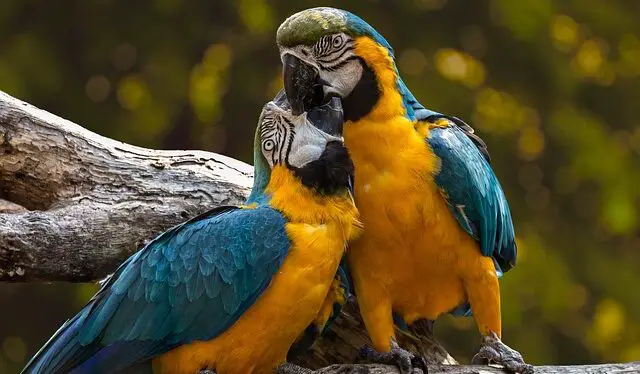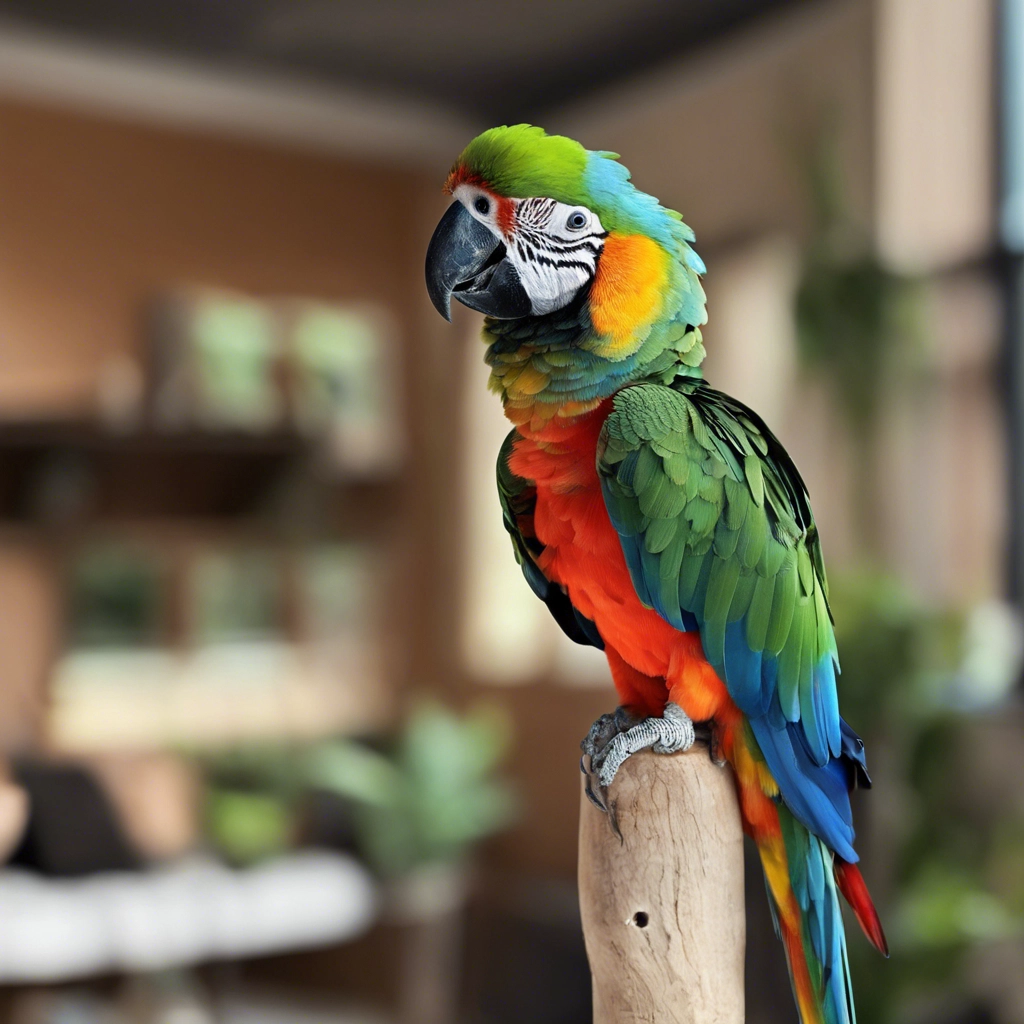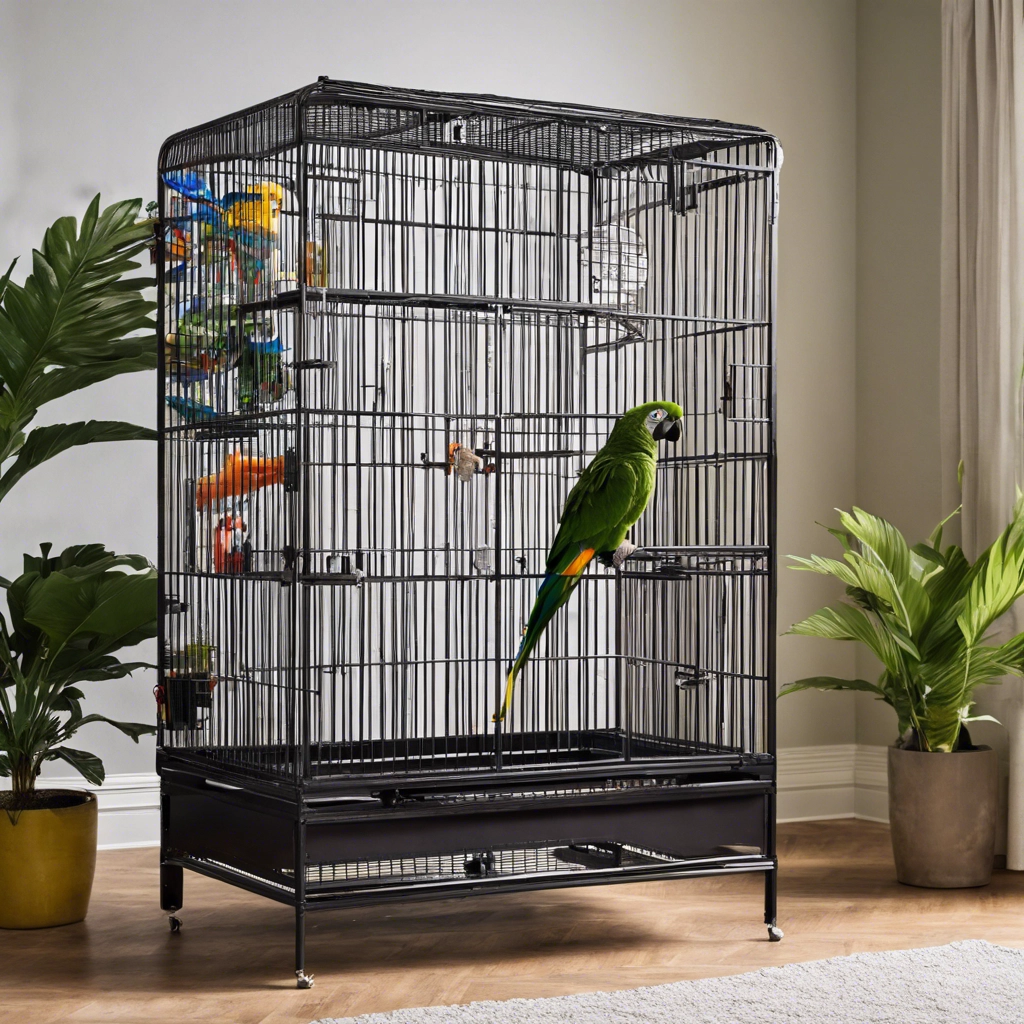Physical Address
304 North Cardinal St.
Dorchester Center, MA 02124
Physical Address
304 North Cardinal St.
Dorchester Center, MA 02124

Becoming a new parrot owner is an exciting experience full of fun and affection ahead. Parrots make lively, outgoing companions that develop close bonds with their owners. Their impressive intelligence and longevity means you may share your life with them for decades to come.
However, the decision to welcome one of these exotic birds into your home should not be taken lightly. Parrots have extremely specialized needs compared to domesticated pets like cats or dogs. They require intensive care, enrichment and supervision that first-time owners often underestimate.
Many eager but unprepared people go into parrot guardianship with the best of intentions. But they soon become overwhelmed and make detrimental mistakes that jeopardize their new feathered friend’s wellbeing. This results in neglected, aggressive, or neurotic parrots that get rehomed or abandoned at alarmingly high rates.
While no one sets out to be irresponsible, lack of thorough research beforehand inevitably leads new parrot owners to become frustrated with the reality of care needed. However, nearly all common pitfalls can be easily avoided right from the start through proper preparation and planning.
By understanding key species-specific requirements, budgeting appropriately for their needs, preparing your home safely, and following expert guidance, you can prevent most issues from ever occurring. Here are five of the most common mistakes new parrot owners make, as well as tips for avoiding them altogether.

There are over 350 recognized parrot species kept as pets today. They vary immensely in terms of size, noise level, grooming needs, aggression risk, talking ability, desired interaction frequency, trainability, dietary preferences, native climate preferences and more. Some smaller species only live 5-10 years total, while the largest macaws and cockatoos may reach 60-80 years old.
Without doing thorough research beforehand, new parrot owners often end up choosing a species poorly suited for their lifestyle, expectations and commitment abilities. This frequently manifests in owners abandoning parrots within just the first year due to feeling overwhelmed.
Common precipitating factors for early surrender include intolerable screaming, unexpected biting and aggression, enormously messy eating habits and play styles, intensive grooming needs leading to respiratory issues, as well as general destructive tendencies – especially towards household moldings.
New owners also often express dismay over the financial burdens, time commitments required for sufficient mental enrichment and socialization, plus general longevity far surpassing assumptions. Certain species also pose greater demands for graspable owners due to heavier weights and dangerous beaks.
To avoid becoming one of the countless owners who regret acquiring an unsuitable parrot, commit extensive time researching beforehand rather than impulse purchasing these long-lived creatures. Here are key considerations to thoroughly investigate about any species under consideration:
Ideally, also try to find local owners of the given species you can meet with for a “test run.” Many will allow potential adopters to come interact with their parrot for an hour or so to better gauge a species’ true temperament. Zoos, avian-specialized pet shops, shelters and rescue groups also often have species-specific parrot meet-and-greet events facilitating hands-on experience. You may even look into foster programs allowing volunteers to home trial certain parrots short-term pre-adoption.
At minimum, have several extensive discussions with experienced owners and breeders specializing in your top species of interest, as well as the veterinarian you plan to use. Ensure you see eye-to-eye on all husbandry best practices and genuinely feel capable of meeting expectations. An experienced outside perspective assessing your lifestyle compatibility can prove invaluable before fully committing.
One of the most common and easily avoidable mistakes new parrot owners make involves failing to buy an adequately sized cage before bringing their bird home. Without sufficient cage dimensions allowing ample ability to open wings fully and maneuver uninhibited, parrots quickly develop severe physical and psychological issues.
As highly intelligent, high energy animals evolved for frequent flights traversing miles daily in vast rainforest canopies, parrots do not cope well with restricted confinement whatsoever. It triggers immense stress that manifests in a devastating range of abnormal coping behaviors indicating domestic situations prove inappropriate for their fundamental wild needs.
The most prominent welfare issues seen in parrots kept in inadequately sized cages involve screaming, aggression, self-mutilation and stereotypic OCD behaviors like constant pacing. Severe feather damaging behaviors also frequently result as they over-preen themselves bald and even mutilate skin in distressed efforts for destructive stimulation. They may also attack perceived cage threats with their beaks, causing damage to their surroundings or self-blunting beak injuries.
From a physical health perspective, overly cramped cages directly inhibit parrots from achieving sufficient exercise. Over-clipped wings unable to achieve flight through opened cages then exacerbate muscular atrophy and nutritional deficiencies associated with obesity. Pressure sores from lack of comfortable perching space may also develop on keels and feet while spending excessive inactive time on cage floors without room to move normally.

Unfortunately, though, the vast majority of first-time owners select pretty powder-coated steel cages marketed specifically towards parrots that seem reasonably sized in pet store displays. However, these cages rarely meet the minimum spatial provisions outlined by avian veterinary experts needed for baseline psychological wellbeing. And they certainly prove wholly inadequate to fulfill species-specific enrichment standards enabling parrots to thrive.
To prevent encountering these devastating issues that ultimately result in premature rehoming or euthanasia, new owners must ensure their parrot’s cage far exceeds bare minimum size guidelines from the start. Be sure to meet the following size recommendations per the Association of Avian Veterinarians, adjusting up for larger/active species or your individual bird’s observed exercise habits:
Also note that while female parrots tend to be smaller, they actually require relatively larger cages because higher energy levels equate more time spent playing versus perching stationary.
Obviously cost remains an inhibiting factor when investigating oversized cage options actually adequate for most parrots, much less customizable elaborate flight cages permitting ample uninhibited movement. However given that cages suitable for parrots typically outlast multiple owners, view this investment as invaluable preventative healthcare ensuring your companion’s welfare.
After sourcing an appropriately sized cage, be sure to place it in a safe, high-traffic area of the home without supplemental hazards like curtains, ceiling fans, or aggressive pets. Keep the surrounding climate temperate without direct light or drafts. Securely lock the cage against inquisitive pets or children opening doors without supervision to prevent escapes. Remove collars/loose clothing when directly interacting around cage doors as well for safety.
While an adequately sized cage forms the fundamental habitation foundation needed for good welfare, keeping parrots confined too much remains an enormously problematic mistake commonly made by new owners. They simply underestimate the unacceptable psychological strain prolonged physical confinement imposes on such biologically hardwired free-flighted beings.
In the wild, parrots spend over 80% of daylight hours traversing miles while foraging and navigating complex social hierarchies. But in captivity, they easily spend over 90% of existence locked inside tiny cages receiving minimal sensory stimulation or choice. This unnatural extreme restriction of movement and autonomy directly triggers pathological behavioral and functional declines from the relentless stress.
Signs of inadequate out-of-cage time involve excessive inactivity/sleeping, self-barbering feathers, screaming for attention, aggression, depression, clinging possessiveness, obesity and muscle wasting. Cognitive skills also deteriorate as neuropathways fail to establish properly without enough environmental enrichment exposure needed during developmental stages.
To prevent these issues, owners must commit providing ample supervised playtime perched or flying free in “parrot-proofed” rooms under direct supervision. This primarily involves blocking access behind heavy furniture/ electronics, restricting ceiling fans, removing poisonous houseplants and securing wires. It also requires thorough initial training for bonding, respect and “step-up/step-down” compliance.
Ideally, companion parrots should enjoy 4-6 hours minimum each day socializing, foraging interactive toys and flying around to satisfy fundamental wild needs. This enrichment time may be divided into multiple sessions adjusted based on individual energy levels and preferences. Prolonged spans inside cages should never exceed secure sleeping hours at night without intermittent socialization or enrichment. Establish an enriching routine alternating direct interaction and independent play suited to your schedule.
Insufficient nutrition constitutes another easily avoided yet common mistake shortening captive parrots’ lifespans and quality of life. New owners tend to default to cheap, filler-packed commercial bird mixes as staples instead of species-appropriate whole foods. But these high-fat, high-sugar seeded diets lead to obesity, malnutrition, fatty liver disease and other issues in otherwise long-lived parrots.
In the wild, parrots consume predominantly vegetable matter while foraging arboreal habitats for berries, buds, nuts, herbs, bark, fungi, insects and mineral clay. Captive diets should mimic this diverse nutrient density within a dominantly veggie-based grain-free diet low in fruit sugars.
Quality veterinary guidelines now advocate homemade diets comprised of:
Meanwhile, you should strictly avoid common junk foods like:
Transition gradually from previous inadequate diets over several weeks to allow gut microflora adaptation and prevent refusal. Incorporate new items slowly in small amounts to establish taste preferences while monitoring toilet habits.
Fine-tune portions based on your parrot’s weight fluctuations noted during regular physical exams. Generally lean body conditions meeting species-specific weight ranges indicate suitable caloric intake. Consult an avian-experienced veterinarian routinely to troubleshoot diet-related issues.
Insufficient mental stimulation ties directly into the previous mistakes mentioned involving overly restricted cage confinement and social isolation. During 80% of their wild waking hours, parrots spend extensive time navigating complex environments, foraging sustainably and dynamically interacting within large social structures. Deprived of age-appropriate sensory and social enrichment duration/diversity long-term, parrots easily grown neurotic and depressed.
In captivity, insufficient daily cognitive enrichment manifests in screaming fits, aggression, self-harm feather damaging tendencies and dysfunctional clinging/aggression. Without constructive physical and mental stimulation outlets, abundant natural curiosity transforms into dangerous boredom.Owners often misinterpret resulting destructive boredom as spiteful behavior or insignificance of needs based on small sizes. But diminished exploratory/foraging time devoted to navigating dynamically complex habitats prevents establishing sound learning, bonding and emotional regulation abilities.
New caregivers tend to provide very limited, repetitive playthings and token training interactions amidst prolonged solitary confinement. But such devastating stimulus deprivation neurologically stunts them. Enriching activities should mentally stimulate species-specific foraging challenges, social bonding behaviors and physical dexterity.
To satisfy cognitive needs and nurture emotional health, commit substantial time regularly exercising their mental faculties. Tailor play sessions and toy rotations promoting their natural skillsets targeting things like:
Beyond directly engaging playtime multiple hours daily, ensure your parrot’s entire habitat supports cognitive growth through:
While intensive compared to pets needing mere potty breaks and affection, fulfilling your parrot’s fundamental enrichment requirements prevents dangerous boredom-related behavior issues over decades together. Investing into their lifelong mental health ultimately nurtures the loving bonds treasured with these incredible feathered friends.
While a steep learning curve faces new parrot owners, following these tips helps avoid the most common pitfalls that trigger physical suffering, premature death or rehoming in vulnerable captive parrots. Never impulse purchase parrots without thoroughly researching specific species needs first concerning noise, space, enrichment priorities and your lifestyle fit. Always oversize the cage, maximize supervised free flight time, feed a nutritious whole food diet and provide ample mental stimulation. Implementing these best practices from day one leads to a healthy parrot that thrives for decades as your beloved companion.
The purchase price alone ranges from $20 for budgies and cockatiels, up to $2,000+ for rare macaws or cockatoos. But first-year setup costs can readily exceed $2,000 for a medium bird once you factor vet exams, DNA sexing, cage, perches, toys, wing clipping, etc. Ongoing proper yearly care often racks up thousands more in costs per bird for fresh foods, cage maintenance, veterinary checkups, toys and sitters.
For first-time owners based on care difficulty, noise level and space constraints, cockatiels, bourke’s parakeets, budgies and maybe pionus parrots tend to acclimate the easiest. The smallest species still require extensive research and sizeable commitments, but their care scales more manageably than large demanding macaws or greys for novice owners.
The average lifespan varies dramatically from only 3-5 years for tiny parrotlets up to 60-80 years for large macaws and cockatoos. The most common pet species like budgies, cockatiels, conures, Amazons and African grays typically enjoy 15-30 years or more with proper husbandry. Their exceptional longevity should be heavily weighed into acquisition decisions requiring long-term planning.
Vocal mimicry ability differs quite a bit between species. In general larger parrots like African grays, Amazons and macaws exhibit the most advanced sound replication skills. Male birds also tend to be better talkers. Smaller parakeets may only mimic a few words or sounds, while some individual birds never talk at all. But even nonverbal parrots communicate affection marvelously through bonding behaviors.
How “cuddly” a parrot species rates overall proves highly subjective based on specific behaviors desired, as well as individual pet personality factors. Small species often perch comfortably cradled in hands when socialized young. Yet prolonged restraint stresses most birds despite enjoying gentle strategic head scratches. As prey animals, parrots rarely appreciate perpetual contact like dogs. But once acclimated to your presence through trusting relationships, many parrots bond intensely with their doting owners.

My name is Shane Warren, the author behind Your Bird Buddy – your ultimate guide to the wonderful world of birds! Unleash your inner avian explorer as we delve into a vibrant library of knowledge dedicated to all things feathered. From learning about diverse bird species from across the globe to understanding their captivating habitats and behaviors, I’m here to fuel your passion for these magnificent creatures. Not only that, but I also provide valuable insights on being a responsible and informed pet bird owner. Join our vibrant community and let’s celebrate the feathered wonders of the world together – one chirp at a time. And be sure to join our Your Bird Buddy Community over on Facebook!